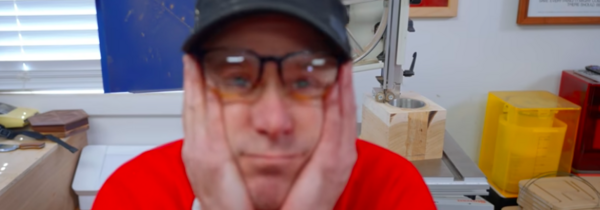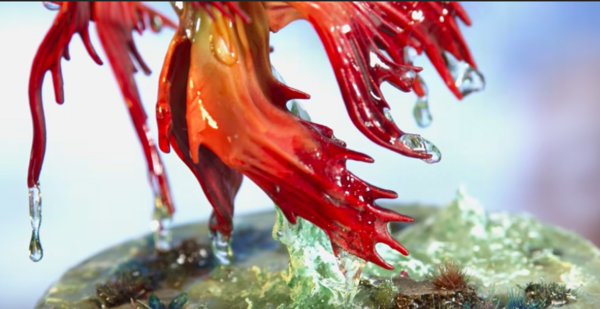Having a REALLY Bad Day in the Shop
Gareth's Tips, Tools, and Shop Tales - Issue #119
Got a tip to share? Tool to recommend? Tall shop tale to tell? A tip to bust? Please share with the class.
Having a REALLY Bad Day in the Shop

Something I wish we saw more of in maker videos is projects that go horribly, irredeemably wrong. On Making Stuff, Dave Picciuto had such a bad day in the shop and wasn’t afraid to share all of the gory details with us. Bad measuring, tools breaking — a LOT of tools – and just a general undignified day at the office. The video was supposed to be about making some wooden mugs with stainless steel whiskey cup inserts. It turned into a lesson on how to roll with it when everything seems to go wrong. In the end, Dave invoked what I call the “Kenny Rogers Rule” (knowing when to hold ’em, when to fold ’em, and when to walk away). He walked away. He’ll revisit this “simple and easy” project some other day. In the end, he added up the cost of replacing all of the parts that broke: SawStop brake, table saw blade, band saw blade, drill press chuck, jointer cutter, and two of the four stainless steel cups that he bought. The cost for his “off” day in the shop? [cue cash register cha-ching] $510. Ouch!
And the Winner is…

On the March 31 Maker Update, Donald Bell announced a giveaway of my new tips book to commenters who shared a tip. We ended up getting over 80 entries. They were all good and it was hard to choose the winners. Below are the 5 winners of Tips and Tales from the Workshop, Vol 2. Please email me your shipping address and I’ll dispatch your book and other goodies.
Brandi Weed – If you have a bunch of small tools (measuring cups, cleaning brushes, etc.) on a split ring, switch them to a D-ring or carabiner. This way, you can remove only the one you need without the others getting in the way and/or needing cleaning because of residual debris.
Federico Maracaglia – Add /zip after the “thing:number” address of a Thingiverse project to download the entire page contents [STL files, images, Read Me file -Ed.] as a Zip file has been one of the coolest tips I’ve discovered recently!
Edward Iglesias – I’m moving so am reminded of this Sherlock Holmes tip:
“A fool takes in all the lumber of every sort that he comes across, so that the knowledge which might be useful to him gets crowded out, or at best is jumbled up with a lot of other things, so that he has a difficulty in laying his hands upon it. Now the skillful workman is very careful indeed as to what he takes into his brain-attic. He will have nothing but the tools which may help him in doing his work, but of these he has a large assortment, and all in the most perfect order.” ― Arthur Conan Doyle, A Study in Scarlet
Shimmering Trashpile – Always document your process. If you’re making a gift, including the documentation makes the gift really personal and unique. Your documentation can be an invaluable resource for a friend making something similar. Also, documentation can be a wonderful memory enhancer when you look back on a project years later.
Dylan Northrup – 10 Tips (because I couldn’t decide on a single one):
1) Remember to dream big, but scope realistically (especially when starting out).
2) Never be afraid to ask for advice. Conversely, always be willing to give advice when asked (but try to avoid giving unsolicited advice).
3) Decide if you’re using Imperial or Metric on a project and stick with it.
4) If you decide some measurements have to be Imperial (e.g. gallons for liquid volume) and some Metric (e. g. milli/centimeters for distance), make SURE the measurements are orthogonal to each other to avoid having to do unit conversion.
5) Efficiency is good, but doing it properly is better. Better to slowly do something once than quickly do it multiple times.
6) If nobody was hurt, no property damaged, and you can try again, it wasn’t a failure, it was a learning experience.
7) You don’t need expensive, feature-laden tools to do good work. Some of the best creativity comes from the limitations we have to work with.
8) Always follow proper safety rules and wear appropriate safety equipment.
9) You can exchange time for money and money for time, but remember it’s possible to make more money… it’s not possible to make more time.
10) Have fun and make sure others have a chance to have fun, too. We’re all in this together.
***
And the Grand Prize of Tips and Tales from the Workshop, Vol 1, Vol 2, and the Maker’s Notebook Gift Set goes to…
Kristian Reinhart – Woodworkers and makers in general often (half-jokingly) quote “You can never have too many clamps.” I’d add some more pieces of wisdom in the same likeness: “You can never have too many ways to hold on to stuff”– various tweezers, clamps, grippers, pliers, jigs, fixtures, and such are incredibly useful to securely holding your workpiece and preventing it from flying off, or injuring yourself or others. “You can never have too many ways to cut stuff” – From different shapes of scissors and knives, chisels, saws, to powered tools like jigsaws, oscillating saws, etc. A variety of cutting implements is tremendously useful when encountering odd materials, angles, and such. Even when doing mundane things like removing supports from 3D prints, I use various pliers, tweezers, awls, and differently-shaped linoleum chisels. “You can never have too many lights” – With how effective and cheap both LED and battery technology have become, it’s now possible to get a whole bunch of different lighting solutions for any given situation. There’s little excuse to strain your eyes with poor lighting when there are so many choices available.
Maker Slang
Jargon, slang, and tech terms from the many worlds of making.
DIWhy – A play on DIY; the questioning of a maker project of dubious merit. See also: Regretsy (said of bizarre Etsy offerings).
Inspired object – Something in your life that’s so well made, so perfectly suited to its task that it actually inspires/elevates you as you interact with it. Things you make yourself often take on this quality. Coined by Mr. Jalopy.
In the sluice – Term used by Adam Savage. Synonymous with in the groove, in the zone.
Using UV Resin for Water Effects

UV resin has become a popular bit of kit within the tabletop game modeling and diorama communities. Using it, you easy to duplicate parts, create window glass, and other cool and realistic tabletop effects by simply depositing the resin and hitting it with a UV light for instant curing. In this Tabletop Time video, they explore the idea of using UV resin to create water bases for sea-based miniatures.
Life Hack: My Approach to Parking
As someone who has significant spinal arthritis, I don’t like to walk far from where we park our car. Over the years, I’ve been told that I have “good parking karma” because I can often find a space close to where we’re going. My method is simple, but it works. First thing is to drive to the exact address you’re going. Don’t decide it’s going to be parked up and park blocks before it because you see a space there. Go to the location and make it your hover point. If you don’t see a space on that block, add one more block to your search area. Circle that small area for a few passes and usually you’ll catch someone leaving. If not, add another block and keep hovering. I’ve rarely had to park more than an extra block from my destination and most often find a spot on the same block.
Shop Talk
In response to the piece on making your own tool wraps, Rex B writes:
“Suggestion for the waxed tool wrap: Add some lanolin to the wax and it will keep those tools rust-free.”
***
Reader Justin Derbes sent me this message:
“I’m building a studio in our back yard and came across this Residential Nailing Schedule chart [PDF link] during a research phase. I thought you might enjoy it.”
05/5/22(Gareth’s Tips, Tools, and Shop Tales is published by Cool Tools Lab. To receive the newsletter a week early, sign up here. — editors)









